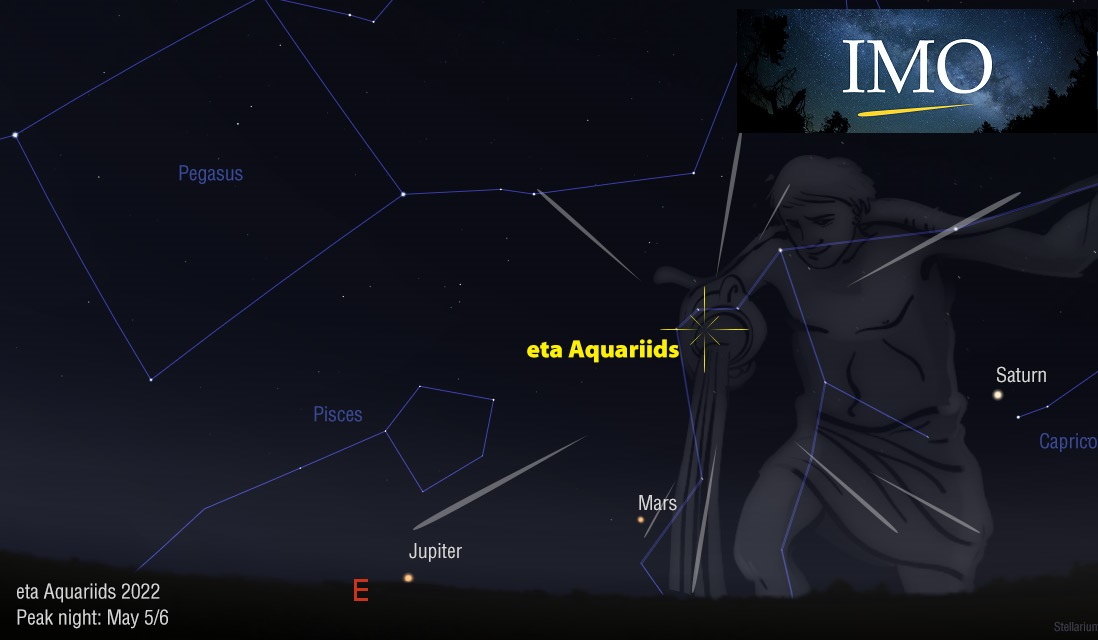Halley’s Comet particles
Every year between mid-April and the end of May, the Earth encounters the outbound debris from Halley’s Comet. Outbound describes the motion of each particle as it moves away from the sun and passes near the Earth on its way back to the outer realms of the solar system. Halley’s comet passes through the inner solar system every 76 years and each one of those passages creates a new stream of particles. These streams each have a slightly different orbit due to planetary perturbations. When a planet passes close to one of these streams the particles get moved ever so slightly out of their previous orbit. Since many of these particles have been orbiting for over two thousand years they can now encounter the Earth anytime during a six week span from mid-April to the last of May. The Earth encounters the mean position of these many orbits on May 5th or 6th of each year. That is when the particle concentration is greatest and we witness the maximum activity of the eta Aquariid meteor shower. It should be noted that the particles we see as meteors separated from the comet many hundreds of years ago as the current orbit of the comet does not cross the orbit of the Earth.
Eta Aquariids in 2022 will peak on May 6
Since the eta Aquariids are the outbound particles of the Halley’s comet, we see them radiate from a point west of the sun. This positioning only allows these meteors to be seen on the morning side of Earth. To make matters more restrictive, the source of these meteors, located in the constellation of Aquarius, does not clear the horizon until 2:00 to 3:00am local summer time as seen from the lower northern latitudes. Viewing circumstances are even worse for mid and upper northern latitudes as the rising of the radiant and the start of morning twilight become closer together as one moves northward. Viewing circumstances for the eta Aquariids are best for those located in the southern tropics where the source of these meteors rises highest in a dark sky. Most observers in the northern hemisphere have only a one to two hour window prior to dawn to view these meteors.
In 2021, the moon was located near the radiant during the shower’s maximum and the display was slightly muted. This year, conditions are better at maximum as the moon sets long before the eta Aquariid radiant rises. To best see this activity one should view during the last two hours prior to dawn. For most of us located in mid-northern latitudes, this will roughly be 3-5am local summer time. This will allow you to see the most possible activity which should be near 10-15 per hour from mid-northern latitudes and up to 30 per hour for southern tropical locations. While the peak is predicted to occur on May 5 and 6, the week centered on these dates will also provide rates near 10 per hour. By May 10, hourly rates will fall below 10 per hour and will slowly fall as the month progresses.

Hourly observations are accepted by the International Meteor Organization. Simply register (it’s free) or log in at www.imo.net and enter your data on their visual meteor observing form. We ask for sessions of at least an hour long due to the fact that meteor activity is notoriously clumpy. This means you may see no activity for 10-15 minutes and then a many meteors within a few minutes. If you limit you watch to less than an hour, you may witness one of those short lulls and be dissatisfied with your results.
This is the beginning of what could be an exciting month for meteor observers. If your skies are clear I encourage you to take advantage of the chance to see bits of Halley’s comet encountering the Earth!




 You saw something bright and fast? Like a huge shooting star? Report it: it may be a fireball.
You saw something bright and fast? Like a huge shooting star? Report it: it may be a fireball.  You counted meteors last night? Share your results with us!
You counted meteors last night? Share your results with us!  You took a photo of a meteor or fireball? You have a screenshot of your cam? Share it with us!
You took a photo of a meteor or fireball? You have a screenshot of your cam? Share it with us!  You caught a meteor or fireball on video? Share your video with us!
You caught a meteor or fireball on video? Share your video with us!